Last Update: March 2006
Normally it takes my a long time to make a decision, but this time I was faster than now can believe myself. I have been reading through a lot of postings and somewhere I read about a company far away in California / U.S.A. making some of of the finest stuff available on the amateur astronomy market. I swept though the website of this company, called StellarVue and was astonished that I had never seen this before. I looked for more information through some search machine and found a lot of stuff. And than I saw what I wanted all the time. A small and highly transportable refractor with many good reputations was there out in the world, the Nighthawk ... So I logged into the Stellarvue Yahoogroup and got some very useful informations. So my decision was not far, I must have IT. Then I saw a posting that Markus Ludes of APM Telescopes imported a few scopes. So it took just two days and here it was. That was a quick decision.
For the first astroimage look here: M57
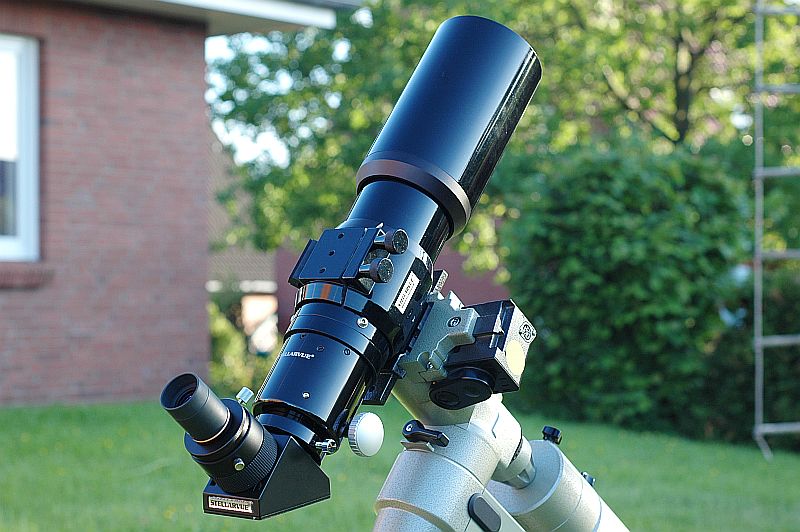
The StellarVue NightHawk f=480mm d=80mm f=1/6 Achromatic Refractor
A very rugged achromatic refractor with a flat field good for astrophotography. It came with a very good bag, a finder and other useful things. I also ordered a 2" dielectric star diagonal. All stuff looks very robust and VERY fine made.
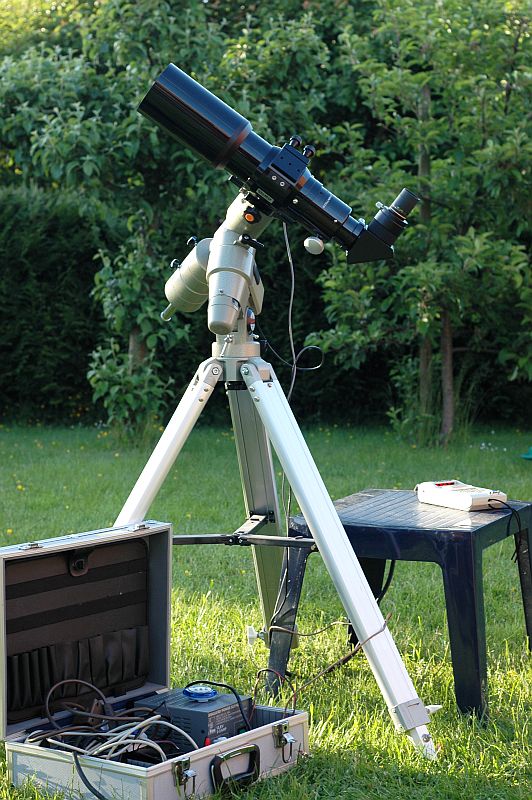
Here is my usual setup (GP Mount with SkySensor3D controller) with the Nighthawk mounted on it (10 June 2005).
Due to the lack of clear sky I took my VIXEN LV 20mm eyepiece and looked to some contrastful objects. The only colour I could find was from the eyepiece I believe. Changing to my Celestron 80/400mm refractor took me back to another world. Coloured fringes around branches in the trees and so on. Then I took some images with the NIKON D70 of a brick wall (The famous wall-test ...). The Nighthawk deliveres a stunning sharp image not to compare with the other refractor.
On the evening of 10 June 2005 there were some clear spots in the sky and I again took the 20mm LV. Even it was still very bright with the sun about 10 degrees above horizon I had a razor-sharp view on the moon. I managed to take a few images with the D70. See below. The only problem was that I had no 2" to T2 adapter; so I used the 1,25" / T2 and T2 / M42, 50mm of M42 extension tube and finally a M42 / Nikon adapters. This resulted in severe vignetting.
StellarVue NightHawk, what is it ?
New: March 2006
I received a very rugged telescope - "built like a tank" as someone said. Everything looks perfectly made. And this is still my impression after having it for 9 months now. And it is well worth spending every cent of the "extra" money.
Visual Performance
I am still very enthousiastic about the brilliant and razor sharp image. Meanwhile I could test it on a number of high-performance eyepieces. Especially with those I don't see much or no false colour at all around bright stars. Eps-Lyrae (1 and 2) can be easily split with a 4mm LV eyepiece. Saturn shows some violett with this ocular but it shows also the Cassini gap all around. I had the chance of viewing the moon with some 9mm TMB?? APO eyepiece. WOW, thats it. I was asked by others around, if I am sure that this is no "APO-Scope". I replied "cool down" ... This is an Achromat. With my eyepieces (some LVs and Orthos) I can not make very big difference to a comparable GSO 80/480mm. But "visually" I am not the expert.
Photographic Performance
If you look through my images here, you will now see a number of images taken through the Nighthawk with CCD camera and the NIKON D70 DSLR. Purple fringes are there and I could only beat them with a BAADER "Fringe Killer" Minus Violet filter. Images are razor sharp in the center but stars get elongated to the corners due to field curvature. This seems to be normal - although I was rather upset at first. I will add a field flattener to my optics.
Comparison
These images are old - I will place new images here !
By taking images of a brick wall you can well see the sharpness:
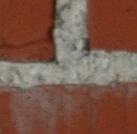 Celestron 80/400mm f5
Celestron 80/400mm f5
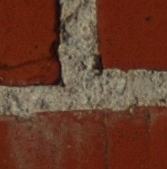 Stellarvue Nighthawk 80/480mm f6
Stellarvue Nighthawk 80/480mm f6
Camera NIKON D70. For the Celestron I was at exactly 20m away from the wall and for the Nighthawk it was 24m to have about the same image size.
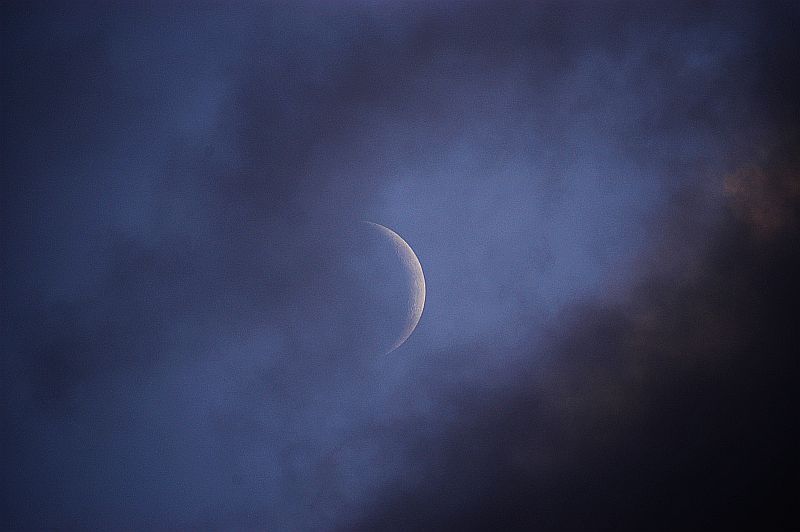
Moon 10 June 2005 ca 2120 CET / Nighthawk 80/480mm 1/800s ISO200 Full Frame. Contrast enhanced.
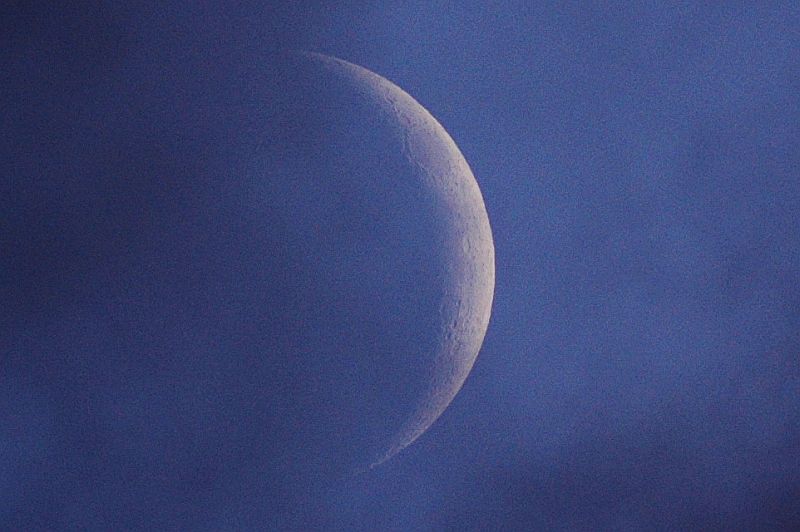
Same Image as above, but the Moon is "cropped out". This is full resolution.
Imaging an airplane ...
We live right under what we call "Luftstraße" ("Airway ..."). You do not have to wait very long for the next to come that way. I have imaged aircraft quite often with my other scopes. But this is somewhat breathtaking - I only mounted the Nighthawk to a photo camera tripod and the clamps were open for easy turning
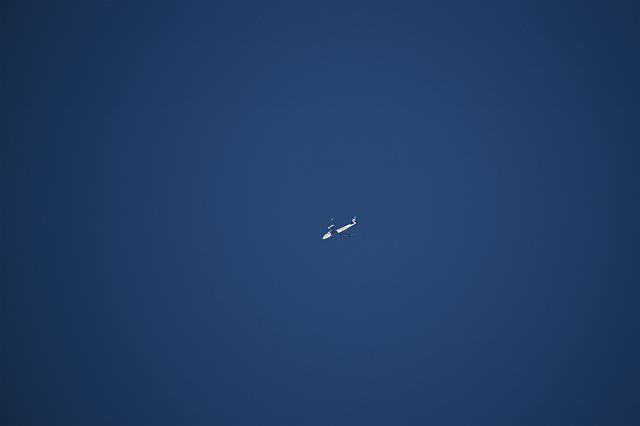
Above: Whole frame resized from 3000*2000 pixel. Taken with 1/1250s and ISO200 from a tripod though the Nighthawk.
Below: Full size crop. Crazy sharp ! The aircraft is at about 15km distance.
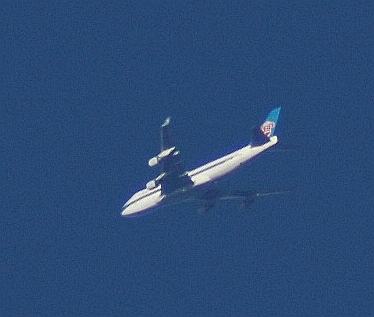
The Moon (13 June 2004)
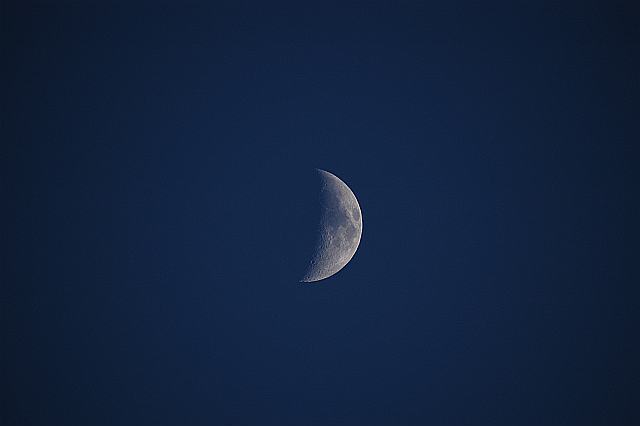
Above: Again a resized image. Taken 1/125s at ISO200 from the phototripod.
Below: A full size crop of the moon. Isn't it beautiful ??
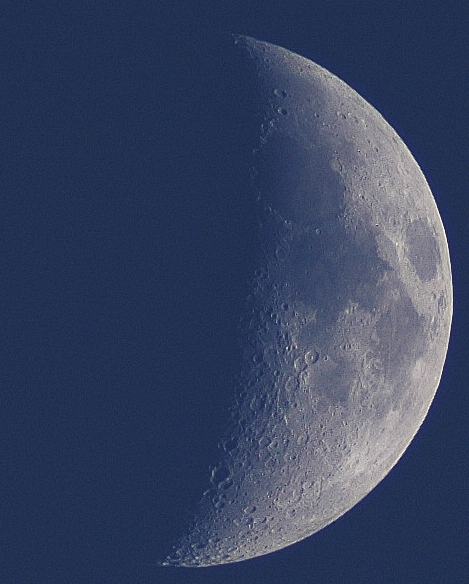
After this I stopped imaging and took my eyepieces and looked at the moon. What a wonderful view for such a small instrument !
Collected from my threads in the STELLARVUE YAHOOGROUP
Hi all,
I am new to this group. I am in Northern Germany and thinking of buying a SV
Nighthawk as highly portable scope. So my question into the group here is
about how does the Nighthawk perform with taking images ? Is the flield
fairly flat enough ? How about false colours ? All I can read that almost
every owner is VERY satisfied with this scope.
I own two refractors; one is a Celestron 80/400mm which I use as large finder
scope and guide scope for a 150/750mm Newtonian. I tried some photos, but
colours around stars are poor and star images are something but not pinpoint.
The scope is one of these China types I believe.
The other refractor is a VIXEN 102M achro refractor, with much much better
performance, but focal lenghts is too high for MY purposes. If I need higher
focal lengths I use my C8 orange, which is a good performer and works not bad
with the focal reducer.
So the 480mm of the Nighthawk seem quite perfect for me and an ED type
refactor of quality is a bit out of my financial range in the moment. I would
sell the 102M for a Nighthawk.
So anyone here to give me some hint and perhaps has take some images (CCD
and/or DSLR) ??
Thanks for your time.
--
Gruss, Greetings,
73 de Christoph Petermann
Guten Tag, Christoph.
Jon Talbot imaged some very nice shots in his SV78S Blackhawk [same optics
as the AT1010] before getting his SV80S that he now images with. Here's the
link to his site - there should be some SV78S shots still on it, last time I
looked:
I have owned my Blackhawk [originally a 2002-vintage Nighthawk retrofitted with a Crayford focuser in 2003] for over 3 years. While I have not done much imaging per se with my scope, it has a very flat field for such a short focal length refractor, and very high quality images. Stars are pin crisp across the field. My scope has some false color on bright targets [Jupiter, Moon, and a handful of bright stars], but the level is very acceptable, given the scope format, and much better than many other achromats out there. In fact, what false color there is present is almost a non-issue visually, given the sharpness of the optics.
Since the newer versions of this scope seem to be even better than the earlier models [Stellarvue is constantly improving things with their scopes] according to reports, I see no reason to be concerned at all. Many people do imaging with these scopes and they do a very nice job. There will be a minus violet filter that SV will be releasing this summer that will assist in curbing the false color considerably. There are also ways to do some very good processing and filtering for longer exposures that help overcome a lot of the false color. I am not an astrophotography expert, so I'll leave that area to folks who no more than I do in this regard.
I am certain that other owners and people who have used this scope for shots of the sky will come on and reply as well. I hope that some of my information was useful to you. Welcome to the group, and good luck with your choice!
Regards, Darren Hennig, Edmonton, Canada
Christoph,
Well, it's a small universe! I am from North Carolina USA. First I have a
nephew who moved to Germany when he married a German girl. Next, my wife
Sharon, who is blind, has an extra class. Her call is WA4AXW. (Be watching
for her on field day on 20 and 40 meter bands on c.w. She recognized your
call right away as German.)
I saw an article in Sky & Telescope magazine a while back that reviewed the
Nighthawk and the now discontinued SV85S. The 85S is an apo and has
basically been replaced by the SV80S triplett. The photos they showed taken
through both scopes were all very good. Sharpness was equal at the center of
the field. The Nighthawk was a little softer at the edges, which could be
expected with an achromat. When I used to photograph through my
SchmidtNewtonian, I would simply crop off the soft edges. You could
certainly do this with the Nighthawk, as it has better edge of field
definition than my 8" SchmidtNewtonian, as well as much wider fov. I don't
know which cameras you are using, but many of them don't cover the entire
fov anyway. You will find the Nighthawk has less false color than the
Celestron 80/400mm, and probably noticeably sharper. The 150/750mm Newtonian
you have is probably a good one. When you photograph through it and you find
the star images not pinpoint, what is the shape of the stars? Stars shaped
like a quarter-moon means the scope needs collimating. If you have doughnut
shapes with little holes in them, your focus was off. Also, bad seeing
conditions can ruin your photos when everything else is perfect. I gave up
photographing through the SN8 because what looked like in-focus to me
usually turned out bad on the print. Photography through my 102 achromat was
easier, although I did not do it much. Other than the false color around the
brightest stars, I found that the color was excellent in my Stellarvue 102d
achromat (now also discontinued.) Lots of pretty shades of white, blue,
yellow, and orange.
Would love to have you as a member of the Stellarvue Family! I enjoy reading
observing reports from users in other countries. In the case of Jupiter, for
example, you will see events that we cannot see here and vice versa.
David Elosser SV85S and SV102d
73's from Sharon
I have been imaging with my three-year-old AT1010 for a few months,
using a Canon 300D at prime focus. My setup is in my highly light-polluted (mag 4)
suburban backyard, but nevertheless I am pleased with the results so far. Here is a
recent crop of my image of M-51:
http://childers.smugmug.com/gallery/414744/1/20133136/Large
Here is a shot of two galaxies in Leo; these objects were almost
directly over a streetlight
across the street, hence the skyglow you can see in the lower right:
http://childers.smugmug.com/gallery/414744/1/21198440/Large
Overall, I'm amazed at how well this little achromat performs under
my poor conditions.
But in my scope there is a lot of distortion at the edges; I crop
that out. There is also
significant violet halos around the brightest stars, but you don't
see them here because
the miracle of Photoshop took care of those problems.
Steve
Hi Chris,
I have a Nighthawk SV1010N, and it is a VG imager. It has a flat
field, and works quite well with a Celestron .63 focal reducer. At
prime focus using a Nikon D70 DSLR, some VG wide field imaging is an
easy task. This shot of NGC 7000 (N.A. Nebula) was taken with such
an arrangement, using a 2" IDAS LPS filter (which I recommend).
http://www.barrie-tao.com/graphics_jpg/svd70_clusters_30sep04.jpg
More shots with SV 1010N at:
http://www.barrie-tao.com/astro_photo.html
Another achromat that has similar performance to the Nighthawk is
the Vixen A80SS. I have used this short tube as an imager, and it
gives semi-APO performance for my experience. Some photos at:
http://www.barrie-tao.com/vixen80ss.html
Ciao...Barry
Hi Christoph,
I imaged with a SV78S (AT1010 with crayford focuser)for a year or
so. The field is very flat. I took flats anyways to get rid of
dust donuts but you can get by without them. Being an Achromat,
false color is present but how much is really dependant upon what
type of camera your using and this can be minimized significantly by
using a -V filter. Stars are pinpoint refractor like. The optics
are much much better than the chinese imports.
As Darren mentioned, you can view some of the images I took with the
SV78 at my website under the Stellarvue link. Most of these were
taken with a MX7C oneshot color camera but a few also with an SXV-H9
mono camera using color filters.
As an Achromat goes, there is no better, especially at this short
focal length.
Jon Talbot
Hi all,
Thanks a lot for all your answers. That looks good and I think I am
going to place an order within the next days. I will let you know.
Greetings Christoph
After I got the Nighthawk there was a posting from Vic Maris, Stellarvue:
Christoph:
Welcome to Stellarvue's growing family. You have a very nice website and I am pleased that we are now a part of it. The importance of having knowledgeable dealers who strive to carry the highest quality products cannot be overlooked. So I am pleased that you were able to get this through Markus as he definately understands the work that we put into the Nighthawks. We are extremely careful to only utilize dealers who understand what we do and how important these steps are in delivering a world class product.
In the case of the Nighthawk, you have obtained the only 80mm f-6 telescope with a flat field, airspaced, hand figured lens that operates at full aperture. The alignment is always perfect thanks to our optical alignment system which is made similar to our apo lenses. It took us two years to develop this telescope and it is something that is truly unique in the field. Hand figuring of an achromat is over the top for a telescope in this class. But doing so we get very consistent star tests, freedom from wedging and good performance under steady skies even at Dawes Limit. This is far beyond the ability of many of the imports but within the capability of every Nighthawk made. We are proud of that.
While Stellarvue makes almost zero profit on the Nighthawk, it is one of the most important telescopes we make. That is because it introduces many people to our line and enables newbies on a limited budget to get a consistently well made telescope that is easy to use. Most of our apo triplet customers started with a Nighthawk. So we are pleased to continue to make this little telescope which is built like a tank and outperforms the other achromats consistently, millimeter for millimeter.
Some people would prefer a lighter telescope. All one has to do is disassemble the lighter telescopes and examine the lens cell to see the difference. Many 80mm telescopes out there use thin lens cells with plastic retainers, cemented lenses that cannot be aligned and baffles that reduce aperture by as much as 10%. This is significant. When one understands the importance of a larger thermally equalized cell, employing all precision machined parts including the tension ring which many lack, you can begin to understand why we get such consistent results. No magic here, just a great attention to what goes into our telescopes, not merely how they look.
I am pleased you found us.
Vic Maris
from Sat 11 June 2005
Thank you VIC for this mail !
To be continued ...